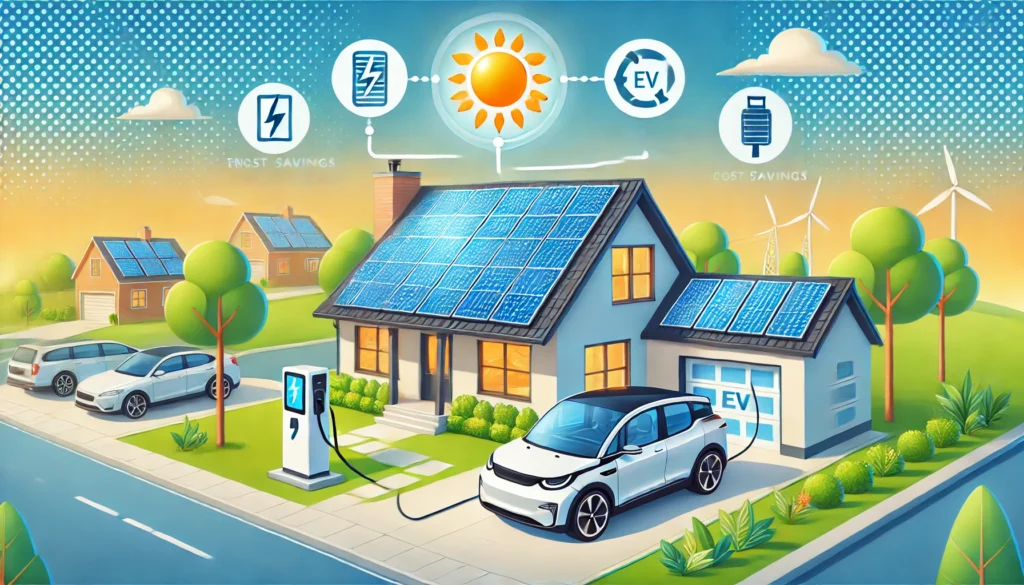Combining Solar Panels with EV Charging at Home: The Ultimate Guide for Maximizing Savings
As electric vehicles (EVs) continue to rise in popularity, more homeowners are seeking efficient, eco-friendly ways to power their cars. One of the smartest strategies is to pair your EV with a residential solar panel system. This combination not only reduces your carbon footprint but also offers substantial long-term savings on energy costs.
In this guide, we’ll explore how integrating solar panels with an at-home EV charging station can maximize your savings, boost energy efficiency, and support a greener lifestyle.
- Why Combine Solar Panels with EV Charging?
Charging an EV at home using traditional grid electricity can add significantly to your monthly energy bills, especially if you drive frequently. Solar energy provides a clean, renewable solution that helps offset these costs.
- Cost Savings: Solar panels generate free electricity from the sun, reducing or even eliminating the cost of charging your EV. Over time, this can save thousands of dollars compared to relying solely on grid power.
- Energy Independence: By generating your own power, you’re less dependent on fluctuating utility rates and rising electricity costs.
- Environmental Impact: Charging your EV with solar energy ensures your transportation is powered by 100% clean energy, drastically reducing greenhouse gas emissions.
Pairing solar with EV charging transforms your home into a self-sufficient energy hub, benefiting both your wallet and the planet.
- How Solar-Powered EV Charging Works
Understanding how solar energy powers your EV is key to optimizing efficiency. Here’s a breakdown of the process:
- Solar Panel Production: Solar panels installed on your roof capture sunlight and convert it into direct current (DC) electricity.
- Inverter Conversion: An inverter transforms DC electricity into alternating current (AC), which is used to power your home and charge your EV.
- EV Charger Integration: A Level 2 home EV charger, connected to your electrical system, draws power from your solar panels. This setup allows for faster, more efficient charging compared to standard outlets.
- Excess Energy Storage: If your solar system produces more energy than you need, it can be stored in a home battery or sent back to the grid (if you have net metering), providing additional savings.
This seamless integration ensures that your EV charging is powered directly by the sun whenever possible.
- Key Benefits of Solar-Powered EV Charging
Significant Long-Term Savings
- Reduced Charging Costs: The cost to charge an EV using grid electricity can range from $0.10 to $0.30 per kWh, depending on your location. Solar energy reduces or eliminates this expense.
- Return on Investment: While there’s an upfront cost for solar panels and an EV charger, the long-term energy savings can quickly offset these expenses, making it a cost-effective investment.
Environmental Impact
- Zero-Emission Transportation: Driving an EV charged with solar power eliminates tailpipe emissions and reduces reliance on fossil fuels.
- Sustainable Living: Combining these two green technologies supports a more sustainable lifestyle and contributes to global efforts to combat climate change.
Energy Independence and Security
- Protection from Rising Energy Costs: By generating your own power, you’re insulated from utility rate hikes.
- Reliable Power Supply: Pairing your solar system with battery storage allows you to charge your EV even during power outages.
- What You Need for a Solar-Powered EV Charging Setup
To create an efficient solar-powered EV charging system, you’ll need the following components:
- Solar Panel System: The size of your solar system should account for both your household energy needs and your EV charging requirements.
- Inverter: A high-quality inverter is essential for converting solar energy into usable electricity. Some inverters are designed to integrate directly with EV chargers for improved efficiency.
- Level 2 EV Charger: A Level 2 charger provides faster charging speeds compared to a standard outlet, typically adding 20–30 miles of range per hour.
- Energy Storage (Optional): Adding a battery storage system allows you to store excess solar energy for nighttime charging or backup power during outages.
Working with an experienced solar provider ensures your system is properly sized and configured to meet your energy needs.
- How to Determine the Right Solar System Size for Your EV
When sizing your solar panel system, consider the following:
- Your EV’s Energy Consumption: On average, EVs consume about 30 kWh per 100 miles. Estimate your weekly driving distance to calculate your EV’s energy needs.
- Household Energy Usage: Factor in your current household electricity consumption to ensure your solar system covers both home and EV charging needs.
- Local Sunlight Conditions: The amount of sunlight your area receives will impact how much energy your solar panels produce.
For example, if you drive 1,000 miles per month, your EV will require approximately 300 kWh of energy. A typical residential solar panel produces around 30–40 kWh per month, meaning you’d need about 8–10 additional panels to cover your EV’s energy demands.
- Maximizing Savings with Smart Charging and Net Metering
To get the most out of your solar-powered EV charging setup, consider these additional strategies:
- Smart EV Chargers: These chargers allow you to schedule charging during peak solar production hours, maximizing the use of your own solar energy and minimizing reliance on the grid.
- Net Metering: If your utility offers net metering, you can send excess solar energy back to the grid and receive credits on your electricity bill. This helps offset the cost of charging your EV during non-sunny hours.
- Time-of-Use (TOU) Rates: Some utilities offer TOU rates where electricity costs less during off-peak hours. By combining TOU plans with solar energy, you can optimize savings.
Implementing these smart charging strategies ensures you’re maximizing efficiency and minimizing costs.
- The Financial Incentives for Solar and EV Charging
The upfront cost of installing solar panels and an EV charger can be offset through various federal and state incentives:
- Federal Solar Tax Credit (ITC): Homeowners can claim a 30% tax credit on the cost of solar installation, significantly reducing upfront expenses.
- EV Charger Tax Credits: The federal government offers tax credits for installing home EV chargers, and some states provide additional rebates.
- State and Local Incentives: Many states offer solar rebates, performance-based incentives, and utility programs that further lower costs.
These incentives make the combination of solar energy and EV charging even more financially appealing.
Conclusion
Combining solar panels with an at-home EV charging station is one of the smartest investments you can make for your wallet and the environment. This powerful duo helps reduce energy costs, increases energy independence, and supports a cleaner, greener future.
If you’re ready to explore how solar energy can power your home and your electric vehicle, contact us today. Our team will help you design a customized system that maximizes efficiency, savings, and sustainability for years to come.
Ready to make the switch?
Contact us today to learn how solar panels can help you save more in the long run!
Complete Residential Solar Panels and Systems. Serving Texas, Oklahoma, Kansas, Missouri, Utah, Florida & Ohio
Get a Free Quote Now
